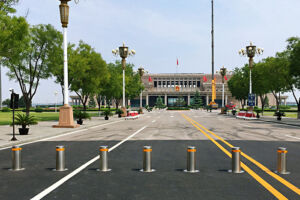Automatic bollards are a type of security barrier that is commonly used to control access to pedestrian zones, private driveways, and restricted areas. They are designed to rise and fall automatically, providing a physical barrier that prevents unauthorized access while allowing authorized vehicles to pass through.
If you’re in the market for automatic bollards, here are some key factors to consider before making your purchase:
Purpose and Use
The first consideration when purchasing automatic bollards is to determine what purpose they will serve and how they will be used. This includes the frequency of use, the size of the vehicles that will be using them, and the level of security required.
For instance, if you need bollards for a busy pedestrian area, you may want to choose bollards that rise and fall quickly to avoid causing a bottleneck. Similarly, if you need bollards to protect a high-security area, you may need bollards that are impact-resistant and designed to withstand a high level of force.
Type of Bollard
There are several different types of automatic bollards available, each with its own advantages and disadvantages. Some of the most common types include:
Hydraulic bollards: These bollards are powered by a hydraulic system and are typically the most durable and reliable option.
Pneumatic bollards: These bollards are powered by compressed air and are typically less expensive than hydraulic bollards, but they may not be as reliable.
Electromechanical bollards: These bollards are powered by an electric motor and are a good option for areas where noise is a concern.
Hydraulic Automatic Bollard
Size and Height
The size and height of the bollards you choose will depend on the size of the vehicles that will be passing through and the level of security required. Typically, automatic bollards come in heights ranging from 600mm to 900mm, and widths ranging from 100mm to 300mm.
For areas where larger vehicles will be passing through, you may need to choose bollards with a larger diameter or height to provide adequate protection.
Control Systems
The control system for your automatic bollards is an important consideration, as it determines how the bollards will operate and how they can be controlled. There are several different control systems available, including:
Remote control: This allows you to operate the bollards from a distance, typically using a handheld remote.
Proximity sensors: These sensors detect when a vehicle is approaching and automatically lower the bollards.
Access control: This allows you to control access to the bollards using a key card or other access control system.
Maintenance and Servicing
Like any mechanical system, automatic bollards require regular maintenance and servicing to ensure that they continue to function properly. When choosing automatic bollards, it’s important to consider the maintenance requirements and the availability of servicing in your area.
Some bollards require more frequent maintenance than others, and some may be more expensive to service or repair. It’s also a good idea to choose bollards from a reputable manufacturer that offers a warranty and reliable after-sales support.
Cost
Finally, cost is always a consideration when purchasing automatic bollards. The cost of the bollards will depend on a range of factors, including the type of bollard, the size and height, the control system, and the manufacturer.
It’s important to balance cost against the level of security and durability required. While it may be tempting to choose the cheapest option available, it’s often worth investing in higher-quality bollards that are designed to withstand the test of time and provide reliable protection.



